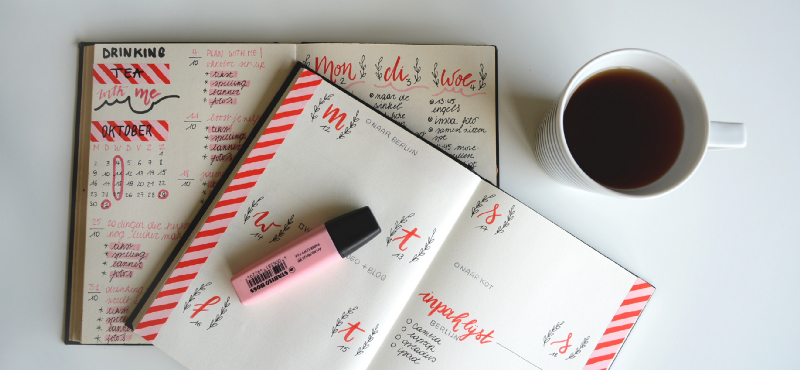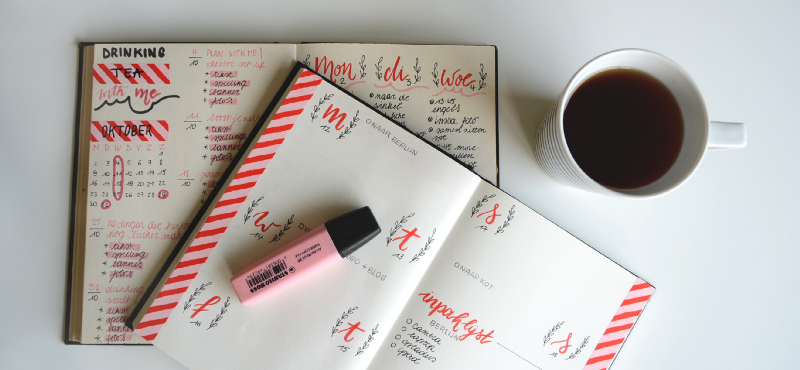Which of the Following Should You Look for When Reviewing Design Format and Programming Issues

by Angela Zhang
How to write a good software design physician

As a software engineer, I spend a lot of time reading and writing design documents. After having gone through hundreds of these docs, I've seen first hand a strong correlation between good design docs and the ultimate success of the project.
This commodity is my try at describing what makes a pattern certificate great.
The article is split into iv sections:
- Why write a design certificate
- What to include in a design certificate
- How to write it
- The process effectually it
Why write a design document?
A design md — as well known as a technical spec — is a clarification of how you plan to solve a problem.
There are lots of writings already on why it'due south of import to write a blueprint doc before diving into coding. So all I'll say here is:
A pattern md is the near useful tool for making certain the correct piece of work gets done.
The main goal of a design doc is to make you lot more than constructive past forcing you to think through the design and get together feedback from others. People ofttimes recall the point of a design medico is to to teach others well-nigh some organisation or serve as documentation later on. While those can be benign side effects, they are not the goal in and of themselves.
As a general rule of thumb, if you lot are working on a project that might take one engineer-month or more, y'all should write a pattern md. Merely don't finish there — a lot of smaller projects could benefit from a mini blueprint medico likewise.
Great! If you are even so reading, you believe in the importance of design docs. Yet, different engineering science teams, and fifty-fifty engineers within the same team, oftentimes write design docs very differently. Then let'due south talk about the content, style, and procedure of a proficient design md.

What to include in a pattern doc?
A design dr. describes the solution to a problem. Since the nature of each problem is different, naturally you'd desire to structure your design doc differently.
To start, the following is a listing of sections that you should at to the lowest degree consider including in your next design doc:
Title and People
The title of your design doc, the author(s) (should be the same equally the listing of people planning to work on this projection), the reviewer(s) of the doc (we'll talk more virtually that in the Process department below), and the date this document was concluding updated.
Overview
A loftier level summary that every engineer at the company should understand and apply to decide if it's useful for them to read the rest of the physician. It should be 3 paragraphs max.
Context
A description of the problem at hand, why this project is necessary, what people demand to know to assess this projection, and how it fits into the technical strategy, product strategy, or the team'south quarterly goals.
Goals and Non-Goals
The Goals section should:
- describe the user-driven impact of your project — where your user might be some other engineering team or fifty-fifty another technical system
- specify how to measure success using metrics — bonus points if y'all can link to a dashboard that tracks those metrics
Not-Goals are equally important to describe which problems y'all won't be fixing and then everyone is on the same page.
Milestones
A list of measurable checkpoints, and then your PM and your manager'southward manager can skim information technology and know roughly when different parts of the projection will be done. I encourage you to suspension the project downwardly into major user-facing milestones if the projection is more than 1 month long.
Use calendar dates and then you take into account unrelated delays, vacations, meetings, and so on. It should expect something like this:
Starting time Engagement: June 7, 2018
Milestone i — New arrangement MVP running in dark-mode: June 28, 2018
Milestone ii - Retire erstwhile organization: July 4th, 2018
End Date: Add characteristic X, Y, Z to new organisation: July 14th, 2018
Add an [Update] subsection hither if the ETA of some of these milestone changes, so the stakeholders can hands run across the about up-to-date estimates.
Existing Solution
In add-on to describing the current implementation, you should too walk through a high level case flow to illustrate how users interact with this organization and/or how data flow through information technology.
A user story is a bang-up way to frame this. Keep in mind that your organisation might have different types of users with different utilize cases.
Proposed Solution
Some people call this the Technical Architecture department. Again, effort to walk through a user story to concretize this. Feel costless to include many sub-sections and diagrams.
Provide a big moving-picture show first, then fill in lots of details. Aim for a world where you lot tin write this, then have a holiday on some deserted island, and another engineer on the team tin but read it and implement the solution every bit you described.
Alternative Solutions
What else did you consider when coming up with the solution in a higher place? What are the pros and cons of the alternatives? Accept you lot considered buying a third-political party solution — or using an open source one — that solves this problem equally opposed to building your own?
Testability, Monitoring and Alerting
I like including this section, because people often care for this as an reconsideration or skip it all together, and it virtually always comes back to bite them subsequently when things interruption and they have no thought how or why.
Cross-Team Touch on
How will this increase on phone call and dev-ops burden?
How much money will it cost?
Does it crusade any latency regression to the organisation?
Does information technology betrayal any security vulnerabilities?
What are some negative consequences and side effects?
How might the support team communicate this to the customers?
Open Questions
Any open problems that you aren't sure virtually, contentious decisions that yous'd like readers to weigh in on, suggested future work, and so on. A tongue-in-cheek proper noun for this department is the "known unknowns".
Detailed Scoping and Timeline
This section is mostly going to be read only by the engineers working on this project, their tech leads, and their managers. Hence this section is at the end of the doc.
Essentially, this is the breakdown of how and when you plan on executing each office of the project. At that place'south a lot that goes into scoping accurately, so yous can read this mail to learn more virtually scoping.
I tend to besides treat this section of the design doc every bit an ongoing project task tracker, so I update this whenever my scoping approximate changes. Simply that'south more of a personal preference.

How to write information technology
Now that we've talked about what goes into a adept design doc, let'southward talk about the way of writing. I promise this is dissimilar than your high schoolhouse English class.
Write as simply equally possible
Don't endeavor to write like the academic papers you've read. They are written to impress journal reviewers. Your physician is written to describe your solution and get feedback from your teammates. You lot tin reach clarity past using:
- Simple words
- Short sentences
- Bulleted lists and/or numbered lists
- Concrete examples, like "User Alice connects her banking concern account, and so …"
Add lots of charts and diagrams
Charts tin oft exist useful to compare several potential options, and diagrams are mostly easier to parse than text. I've had good luck with Google Drawing for creating diagrams.
Pro Tip: think to add together a link to the editable version of the diagram nether the screenshot, so you tin easily update it later when things inevitably alter.
Include numbers
The scale of the problem frequently determines the solution. To help reviewers get a sense of the state of the world, include real numbers like # of DB rows, # of user errors, latency — and how these scale with usage. Remember your Big-O notations?
Try to be funny
A spec is non an academic paper. Also, people like reading funny things, and then this is a good way to keep the reader engaged. Don't overdo this to the point of taking abroad from the cadre idea though.
If you, like me, take trouble being funny, Joel Spolsky (obviously known for his comedic talents…) has this tip:
Ane of the easiest ways to be funny is to exist specific when information technology'south not called for [… Example:] Instead of maxim "special interests," say "left-handed avacado farmers."
Do the Skeptic Exam
Earlier sending your blueprint medico to others to review, take a pass at it pretending to be the reviewer. What questions and doubts might you take about this design? Then address them preemptively.
Practice the Vacation Examination
If yous go on a long vacation at present with no internet admission, tin can someone on your team read the dr. and implement it every bit you lot intended?
The main goal of a pattern doc is not knowledge sharing, merely this is a good way to evaluate for clarity so that others tin actually give you lot useful feedback.

Procedure
Ah yes, the dreaded P-word. Design docs aid you get feedback before you waste a bunch of time implementing the wrong solution or the solution to the wrong trouble. There'due south a lot of art to getting skillful feedback, but that's for a later article. For at present, let's merely talk specifically about how to write the blueprint medico and get feedback for it.
First of all, anybody working on the projection should be a part of the design process. It's okay if the tech lead ends up driving a lot of the decisions, but everyone should be involved in the word and buy into the design. Then the "yous" throughout this commodity is a actually plural "you" that includes all the people on the project.
Secondly, the design procedure doesn't hateful you staring at the whiteboard theorizing ideas. Feel gratuitous to get your hands muddied and prototype potential solutions. This is not the aforementioned as starting to write product code for the project earlier writing a design doc. Don't exercise that. But you absolutely should feel free to write some hacky throwaway code to validate an idea. To ensure that y'all but write exploratory code, arrive a rule that none of this prototype lawmaking gets merged to principal.
After that, as you first to have some thought of how to go about your project, do the following:
- Ask an experienced engineer or tech lead on your squad to be your reviewer. Ideally this would be someone who'southward well respected and/or familiar with the edge cases of the problem. Bribe them with boba if necessary.
- Get into a briefing room with a whiteboard.
- Draw the trouble that you are tackling to this engineer (this is a very important footstep, don't skip it!).
- Then explain the implementation you have in mind, and convince them this is the right thing to build.
Doing all of this before you even start writing your design md lets y'all go feedback every bit shortly as possible, earlier you lot invest more than time and get attached to any specific solution. Often, even if the implementation stays the same, your reviewer is able to betoken out corner cases y'all need to cover, signal whatever potential areas of confusion, and anticipate difficulties yous might run across later on on.
Then, after you've written a rough draft of your pattern dr., get the aforementioned reviewer to read through information technology once again, and rubber postage stamp it past adding their name as the reviewer in the Title and People section of the pattern doctor. This creates additional incentive and accountability for the reviewer.
On that annotation, consider adding specialized reviewers (such as SREs and security engineers) for specific aspects of the design.
Once you lot and the reviewer(s) sign off, feel costless to send the design dr. to your squad for additional feedback and knowledge sharing. I suggest time-bounding this feedback gathering process to near 1 week to avoid extended delays. Commit to addressing all questions and comments people leave inside that week. Leaving comments hanging = bad karma.
Lastly, if there'due south a lot of contention between you, your reviewer, and other engineers reading the physician, I strongly recommend consolidating all the points of contention in the Discussion department of your doc. And so, prepare a meeting with the different parties to talk about these disagreements in person.
Whenever a discussion thread is more than five comments long, moving to an in-person discussion tends to be far more than efficient. Continue in heed that you are still responsible for making the terminal call, fifty-fifty if everyone can't come to a consensus.
In talking to Shrey Banga recently about this, I learned that Quip has a similar procedure, except in improver to having an experienced engineer or tech lead on your team as a reviewer, they as well suggest having an engineer on a different team review the doc. I haven't tried this, but I can certainly see this helping get feedback from people with different perspectives and improve the general readability of the doc.
Once yous've done all the above, time to go going on the implementation! For extra brownie points, treat this design medico as a living document as you lot implement the pattern. Update the doctor every fourth dimension you learn something that leads to you making changes to the original solution or update your scoping. You'll give thanks me later when you don't accept to explain things over and over again to all your stakeholders.
Finally, let'south become really meta for a second: How exercise we evaluate the success of a design doc?
My coworker Kent Rakip has a good answer to this: A design doc is successful if the right ROI of work is done. That ways a successful design doc might actually pb to an outcome like this:
- You spend 5 days writing the design doc, this forces you to think through different parts of the technical architecture
- You get feedback from reviewers that
10is the riskiest function of the proposed architecture - Yous decide to implement
Xfirst to de-take chances the projection - 3 days later, you effigy out that
Xis either not possible, or far more difficult than you originally intended - You determine to stop working on this project and prioritize other work instead
At the commencement of this commodity, we said the goal of a blueprint doctor is to brand certain the right work gets done. In the case in a higher place, thanks to this pattern physician, instead of wasting potentially months only to abort this projection after, you've only spent eight days. Seems like a pretty successful consequence to me.
Please leave a comment beneath if you have any questions or feedback! I'd besides love to hear about how you do blueprint docs differently in your team.
Giving credit where credit is due, I learned a lot of the above by working alongside some incredible engineers at Plaid (we are hiring! Come up design and build some sugariness technical systems with u.s.) and Quora.
If you like this post, follow me on Twitter for more than posts on engineering, processes, and backend systems.
Learn to code for free. freeCodeCamp's open up source curriculum has helped more than twoscore,000 people become jobs every bit developers. Get started
Source: https://www.freecodecamp.org/news/how-to-write-a-good-software-design-document-66fcf019569c/
0 Response to "Which of the Following Should You Look for When Reviewing Design Format and Programming Issues"
Post a Comment